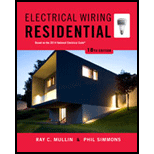
Electrical Wiring Residential
18th Edition
ISBN: 9781285170954
Author: Ray C. Mullin, Phil Simmons
Publisher: Cengage Learning
expand_more
expand_more
format_list_bulleted
Concept explainers
Question
Chapter 5, Problem 4R
To determine
Find the switch and its rating to control five 300-watt tungsten filament lamp on 120-volt circuit.
Expert Solution & Answer
Trending nowThis is a popular solution!

Students have asked these similar questions
22: Line charges PL
2π nC/m are located at xy-plane as shown in Figure-1, find
the electric field intensity (E) at (0, 0, 2)?
2
11.4 Determine Vout in the circuit shown in Fig. P11.4. through any method
Solve the following nonlinear system using Newton's method
1
f1(x1, x2, x3)=3x₁ = cos(x2x3)
-
-
2
f2(x1, x2, x3) = x² - 81(x2 +0.1)² + sin x3 + 1.06
f3(x1, x2, x3) = ex1x2 +20x3 +
Using x (0)
X1 X2 X3
10π-3
3
= 0.1, 0.1, 0.1 as initial conditio
Chapter 5 Solutions
Electrical Wiring Residential
Ch. 5 - The identified grounded circuit conductor must be...Ch. 5 - Explain how lighting switches are rated.Ch. 5 - Prob. 4RCh. 5 - Prob. 5RCh. 5 - To control a lighting load from one control point,...Ch. 5 - Prob. 7RCh. 5 - Complete the connections in the following...Ch. 5 - Complete the connections for the diagram....Ch. 5 - A three-way switch may be compared to a _____...Ch. 5 - Prob. 11R
Ch. 5 - Complete the connections in the following...Ch. 5 - When connecting 4-way switches, care must be taken...Ch. 5 - Show the connections for a ceiling outlet that is...Ch. 5 - Match the following switch types with the correct...Ch. 5 - When connecting single-pole, 3-way, and 4-way...Ch. 5 - What section of the Code emphasizes the fact that...Ch. 5 - If you had to install an underground 3-wire feeder...Ch. 5 - Is it always necessary to attach the bare...Ch. 5 - List the methods by which an equipment grounding...Ch. 5 - When two nonmetallic-sheathed cables (Type NM-B)...Ch. 5 - Define an equipment grounding conductor.Ch. 5 - When metal toggle switchplates are used with...Ch. 5 - Does the Code permit the ampacity of switch legs...Ch. 5 - Prob. 26RCh. 5 - Prob. 27R
Knowledge Booster
Learn more about
Need a deep-dive on the concept behind this application? Look no further. Learn more about this topic, electrical-engineering and related others by exploring similar questions and additional content below.Similar questions
- Use Newton-Raphson method to solve the system x² - 2x-y+0.5= 0 x² + 4y² 4 = 0 - with the starting value (xo,yo) = (2,0.25) and two iteration number.arrow_forwardReversing 3⍉ Motors using manual starters with wiring diagram of forward contacts and reverse contacts.arrow_forwardDetermine (a) the input impedance and (b) the reflectedimpedance, both at terminals (a,b) in the circuit of Fig. P11.14.arrow_forward
- 11.4 Determine Vout in the circuit shown in Fig. P11.4.arrow_forwardFor the circuit in Fig. P11.1, determine (a) iL(t) and (b) theaverage power dissipated in RL.arrow_forwardDesign a synchronous Up/Down counter to produce the following sequence (4 9 2,0,7,6,3,1,5) using T flip-flop. The counter should count up when Up/Down =1, and down when Up/Down = 0.arrow_forward
- Solve the following systems using Gauss Seidal and Jacobi iteration methods for n=8 and initial values X0=(000). - 2x16x2 x3 = -38 - -3x1 x2+7x3 = −34 -8x1 + x2 - 2x3 = -20arrow_forwardSolve the following systems using Gauss Seidal and Jacobi iteration methods for n=8 and initial values Xº=(000). 3x12x2x3 = 4 - 2x1 x2 + 2x3 = 10 x13x24x3 = 4arrow_forwardUse Newton-Raphson method to solve the system x² - 2x-y+0.5= 0 x² + 4y² 4 = 0 - with the starting value (xo,yo) = (2,0.25) and two iteration number.arrow_forward
- Solve the following systems using Gauss Seidal and Jacobi iteration methods for n=8 and initial values X0=(000). - 2x16x2 x3 = -38 - -3x1 x2+7x3 = −34 -8x1 + x2 - 2x3 = -20arrow_forwardSolve the following nonlinear system using Newton's method 1 f1(x1, x2, x3)=3x₁ = cos(x2x3) - - 2 f2(x1, x2, x3) = x² - 81(x2 +0.1)² + sin x3 + 1.06 f3(x1, x2, x3) = ex1x2 +20x3 + Using x (0) X1 X2 X3 10π-3 3 = 0.1, 0.1, 0.1 as initial conditioarrow_forwardA single phase a.c. distributor AB has: The distance from A to B is 500 m. The distance from A to C is 800 m. The impedance of each section is (6+j 8) /km. A B C The voltage at the far end is maintained at 250 volt. Find: sending voltage, sending current, supply power factor and 80 A 60 A total voltage drop. 0.8 lag. P.f 0.6 lead. p.farrow_forward
arrow_back_ios
SEE MORE QUESTIONS
arrow_forward_ios
Recommended textbooks for you
 EBK ELECTRICAL WIRING RESIDENTIALElectrical EngineeringISBN:9781337516549Author:SimmonsPublisher:CENGAGE LEARNING - CONSIGNMENT
EBK ELECTRICAL WIRING RESIDENTIALElectrical EngineeringISBN:9781337516549Author:SimmonsPublisher:CENGAGE LEARNING - CONSIGNMENT

EBK ELECTRICAL WIRING RESIDENTIAL
Electrical Engineering
ISBN:9781337516549
Author:Simmons
Publisher:CENGAGE LEARNING - CONSIGNMENT